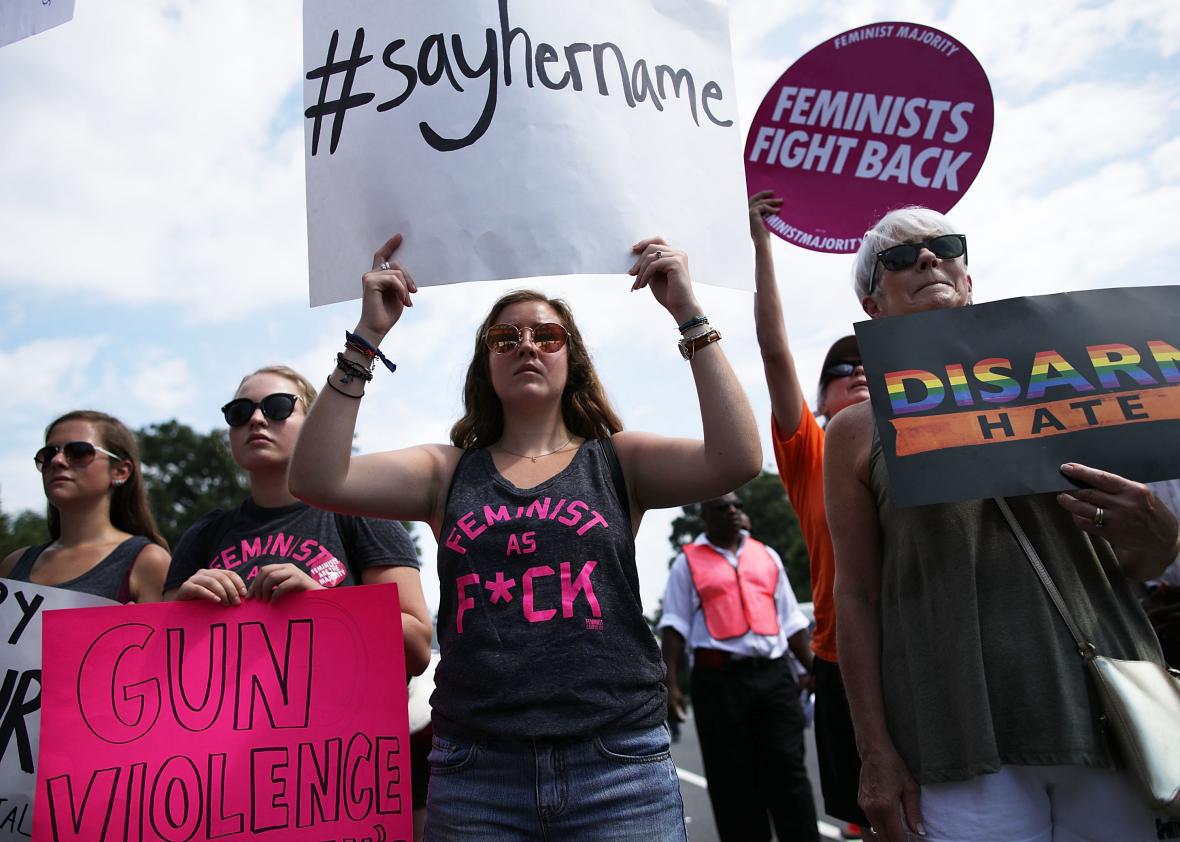In the nearly six months since the Women’s March on Washington, organizers have tried to maintain momentum among the millions who attended one of the hundreds of demonstrations around the country. Some attendees were experienced activists or career advocates; many others were first-time demonstrators pushed to action by the previously unfathomable occasion of Donald Trump’s election. With a robust social media presence and a wide network of volunteers, march leaders have kept up with the rotating scandals in the White House and the health care bombs in Congress. They’ve organized a general strike, helped women register to vote, and told followers when and how to lobby their representatives.
On Friday, organizers are holding their highest-profile action since January’s event. They’ve raised nearly $100,000 to support an 18-mile march from the National Rifle Association headquarters in Fairfax, Virginia, to the Department of Justice building just a few blocks from the White House. Marchers will make the walk on Friday then gather for a rally and vigil at DOJ headquarters on Saturday morning.
Organizers decided to focus such a major effort on the NRA after the pro-gun group released a video this spring that cast anti-Trump protesters as violent maniacs who “smash windows, burn cars, shut down interstates and airports, bully and terrorize the law-abiding, until the only option left is for the police to do their jobs and stop the madness.” The video starred right-wing radio host Dana Loesch, whose sneering way of saying the phrase “racism and sexism and xenophobia and homophobia” is Italian chef–kiss remarkable.
The scaremongering ad, along with the acquittal of the police officer who killed licensed concealed-carrier Philando Castile, prompted Tamika Mallory, one of the original organizers of the Women’s March, to write an open letter to NRA Executive Vice President Wayne LaPierre. In it, Mallory demanded that the NRA remove the Loesch video, which called on gun owners to “fight this violence of lies with the clenched fist of truth,” a phrase many believed was a veiled call to attack anti-Trump demonstrators. “Before the Second Amendment was the First Amendment,” Mallory wrote. “The advertisement released by the NRA is a direct attack on people of color, progressives and anyone who exercises their First Amendment right to protest. … You are calling for our grassroots, nonviolent resistance movement to be met with violence.” Mallory also asked LaPierre to release a statement supporting Castile’s right to own his gun and condemning the officer who killed him, an issue on which the NRA has been conspicuously quiet. In response, the NRA released a video telling Mallory “not a chance.”
So the Women’s March organized its 18-mile walk, making gun violence and police murders of people of color two of the first big targets of its postmarch activism. The Women’s March has made “we are not safe” the catchphrase of this particular action, recognizing the common refrains of activists involved in both the Movement for Black Lives and gun-control efforts. It’s also refreshing to see such deep commitment from organizers and volunteers to advocating on matters of justice that aren’t normally shunted into the “women’s issues” tent, such as equal pay and abortion access. (The Women’s March has spoken on these issues too, especially in its International Women’s Day strike, but they’ve been just a couple of points on the map of its actions.) One of the things that made the original march such a giant success was its wide-reaching, super-progressive platform that took an intersectional big-tent approach to women’s activism. Women lead full, diverse lives, the platform recognized, so every issue—immigration, labor rights, climate justice—is a women’s issue.
This approach owes a lot to decadeslong efforts by women of color to expand reproductive rights to a reproductive justice framework concerned not just with the right to decide whether to have children, but also with access to quality care and the ability to give children safe, healthy upbringings. Weaker gun laws also disproportionately harm women. State by state, research has shown, more guns mean more killing of women. More than half of U.S. mass shooters start out as domestic abusers, but loopholes in every state let domestic abusers keep their guns or even buy new ones.
In the days after January’s march, critics wondered whether organizers could translate the overwhelming turnout into real social change. David Brooks, the sandwich sensei who moonlights as a political commentator, opined that “these marches can never be an effective opposition to Donald Trump.” Friday’s march will not shut down the NRA or remove Trump from office. But with its NRA-to-DOJ action, the Women’s March has successfully united survivors of gun violence, anti–police brutality activists, members of activist groups founded after the Pulse massacre, and major gun-control advocates. Castile’s mother, too, sent a statement to be read at the NRA rally. This coming together of organizations in different but intersecting spheres of advocacy is an impressive feat of solidarity that has almost certainly gotten some newer activists out of their comfortable issue zones. Sometimes, the biggest and best effects of a protest are on the participants, not the targets.
